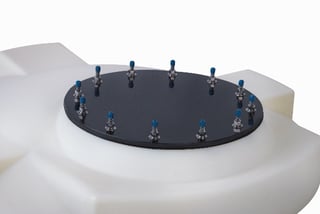Getting to Know Flocculants, like Ferric Chloride
%20copy-1.jpg?width=842&height=442&name=Getting%20to%20Know%20Flocculants%2c%20like%20Ferric%20Chloride%20(1)%20copy-1.jpg)
Ferrics, alums and polymers are commonly used to treat water and wastewater. There are several reasons why these substances require specialized storage:
- Separation, settling and coagulation are major issues with these chemicals – and those conditions can be compounded by temperature variations.
- Settling and separation issues can lead to difficulty in pumping the chemicals.
- The chemicals are often delivered at elevated temperatures, testing the expansion and contraction capabilities of a tank.
- Ferrics create fumes that can defoliate surrounding trees and plants.
- Polymers can act as an environmental stress-cracking agent.
By providing the right kind of storage for these chemicals, safety can be maintained – and the integrity of the product can be preserved.
A flocculant is a substance that promotes the clumping of particles so that they may be removed from water. Flocculants are essential in proper water treatment. One particularly popular flocculant is Ferric Chloride.
Ferric Chloride has been commercially available in the United States since the 1930's, but it is only in the last 20 years that we've seen a trend of increased acceptance of Ferric Chloride for drinking water treatment. This trend is likely due to the chemical's improvements in product economics, quality and availability in the United States.
How Is Ferric Chloride Produced?
As one of the purest and most concentrated forms of iron commercially available for water treatment, Ferric Chloride has a unique distinction. In order to produce Ferric Chloride, Ferrous Chloride must be used. It is the oxidation of Ferrous Chloride with Chlorine that creates this new compound.
Using Ferric Chloride in the Water Treatment Industry
Ferric Chloride offers versatility in the water treatment industry by working as a flocculant and coagulant, as well as a reactant. It promotes faster sedimentation in general and specifically, better sedimentation in cold water, making it an ideal choice for the industry.
Ferric Chloride has several applications in the potable water industry, including both high and low turbidity removal, enhanced coagulation, NOM (natural organic matter), DBP (disinfection by-products) precursor removal, color removal, arsenic reduction softening solids sedimentation aid, and as a filtration aid.
Safely Storing Ferric Chloride
It is extremely important that we handle Ferric Chloride, and all chemicals, with respect and in a safe manner. This holds true to safe chemical storage as well.
Ferric Chloride is also used as an etching medium, meaning it should not be stored in a FRP tank, as the chemical would compromise the tank. For safe storage, we recommend a high-density crosslinked polyethylene tank.
Not all high-density polyethylene tanks are created equal. Although they sound nearly identical, linear polyethylene and crosslinked polyethylene (XLPE) chemical storage tanks have significant differences. Those differences could impact your organization’s bottom line, your people’s safety and the operations of your facility.
Both linear polyethylene and XLPE tanks are made with heated resins to create a cured plastic. However, the differences in their production create very different polyethylenes with very different structural strength.
Crosslinking is simply the formation of bonds between the polymer chains. These bonds, equal in strength and stability to the principal bonds along the polymer backbone, tie the polymers together, thus dramatically increasing molecular weight. In fact, the length of the polymer chains and, therefore, the physical properties, are much better than can ever be achieved without crosslinking.
The result is a plastic that possesses impact resistance, tensile strength and resistance to fracture that linear polyethylene just can’t match. These qualities make crosslinked polyethylene an excellent choice when tank integrity is critical. The structural integrity, heat resistance and useful life in most cases are unparalleled.
Poly Processing has NSF-61 certification for 38 chemicals on its crosslinked polyethylene tanks.
Ferric chloride is also a high fuming chemical. These fumes can potentially defoliate surrounding trees and plants.

When storing Ferric Chloride in a chemical storage tank, a fume-tight manway lid cover prevents fumes from escaping the tank. Adding a scrubber provides a cost-effective solution to address any potential fuming into the atmosphere while using ferric chloride.
Our crosslinked polyethylene tanks are able to store up to 96% concentration of Ferric Chloride, with a tank that has a specific gravity rating of 1.65, with PVC fitting materials, EDPM gaskets, and titanium bolts.
Learn more about Ferric Chloride by downloading our complete product catalog today, or contact a chemical storage tank expert to get answers to your questions.
- June 26, 2023
- Topics: Chemicals
About Poly Processing
Posts By Topic
Tech Talk Podcast Episodes
Subscribe By Email
Recent Posts
- Installation Tips for Chemical Storage Tanks: Site Preparation and Offloading
- Understanding pH and Chemical Concentration When Choosing a Chemical Tank
- Maximizing Fill Efficiency: Selecting the Optimal Fill Line System
- Chemical Storage Tanks: A Quick Guide for End Users
- Popular Customization Options for Chemical Storage Tanks
Tank Configurator

Find the recommended tank and system components for your chemical storage challenge.
Configure a Tank Package







